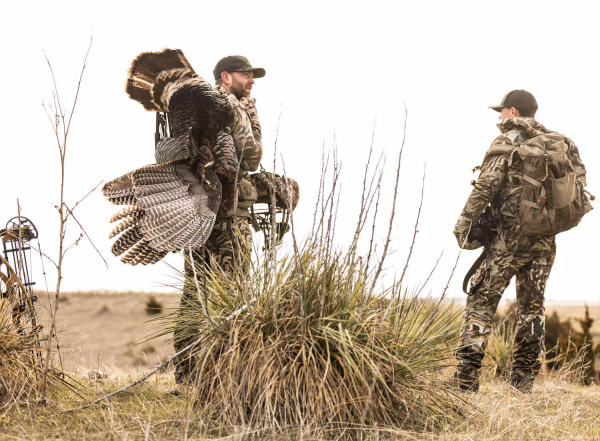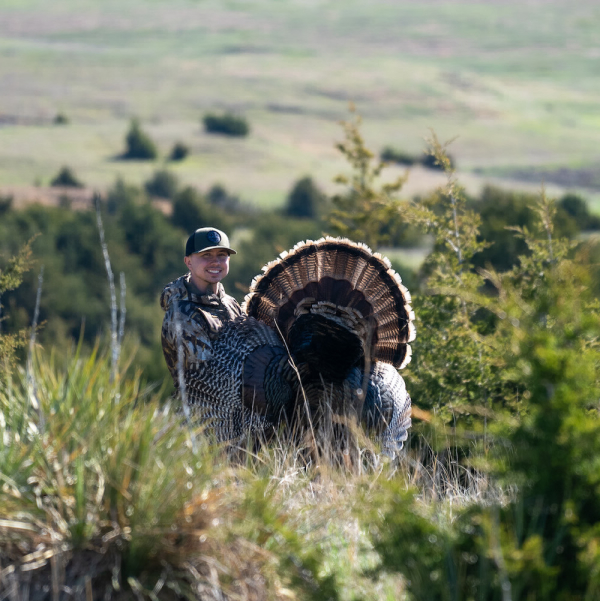

|
It’s doubtful any other game species compels hunters to travel around the country with such vigor as the wild turkey, and then do it in such a relatively short period of time. Depending on the location, wild turkey seasons stretch from March through early-June, and for many hunters, hearing the rattling gobble of mature tom during breeding season is worthy of multiple road trips.
There are five subspecies of wild turkey in the US, including the Osceola, Eastern, Rio Grande, Merriam’s, and Gould’s. Some turkey hunters may even attempt one of the various “slams,” which entails tagging a specific combination of subspecies and registering them with the NWTF.
And one of the more unique of the bunch is the Merriam’s wild turkey.
Merriam’s are found at higher elevations throughout the Mountain West, often where Ponderosa pine is interspersed with meadowy openings. Merriam’s are hearty birds living on the edge of survivability during harsh winters, but somehow, they manage to make it through. They feed on a variety of seeds, berries, and insects during warmer months, but throughout winter, Ponderosa pine seeds are critical for survival.
While many turkey seasons are coming to an end, plenty of states offer seasons that run to the end of the May, and even June in a few instances. Where Merriam’s can be hunted, the month of May is prime time and there really is nothing like harvesting a white-tipped Merriam’s gobbler in a setting that looks more like elk country than the typical place where wild turkey flourish.
Western Obsession TV host and TUO Pro, Kurt Belding, may be known for hunting mountain big game such as the majestic Rocky Mountain elk, but he has also spent quite a bit of time chasing wild turkey, including the wily Merriam’s of the west.
“I grew up in Nebraska hunting Rios and you may find them in some of the creek bottoms in the mountainous regions, but the mountain birds are Merriam’s,” said Belding who now resides in the Colorado.
Many turkey hunters are familiar with the widespread eastern and Rio Grande subspecies – and there are many similarities between them and the Merriam’s, but there are also notable differences in behavior, and of course coloration. While roughly the same size as the Eastern and Rio Grande, Merriam’s are easily recognized for their striking, white tail tips, and light buff tips on their tail coverts. Merriam’s have less pronounced barring on their lighter colored wing primaries than the other two sub-species as well as shorter spurs and beards on average. While they are often vocal, the Merriam’s gobble is considered the weakest in terms of volume and intensity.
“The calls are very similar, and the language doesn’t really change that much either,” explained Belding. “I feel one of the most notable differences between Rios, Easterns, and Merriam’s is they are on the move a lot, and I’m talking mountain turkey hunting. There aren’t creek bottoms and ag fields, you’re in the foothills, you’re in the deep mountains, and as soon as they hit the ground they are on the move. They want to get somewhere – they have a destination in mind.”
“Merriam’s aren’t going to just mill around the same area as the other subspecies often do. Instead of hunting from a blind or remaining set up on a given spot, this is more of a run and gun style hunting strategy. I’m locating and trying to get in front of them where I think they’re headed. Maybe I’ll use a decoy, maybe I won’t,” he added.
Merriam’s are known to be very responsive to hen vocalizations, which makes them especially attractive to turkey hunters, and though it isn’t flat ground, their preferred habitat isn’t difficult to find.
“I like box calls to locate, but when working a bird, I use a mouth call so I can remain hands free.”
Typically, Merriam’s are going to avoid difficult terrain when possible, so deep bottoms and steep hills are not ideal. Gobblers will often look for ridges to move along, which allows them to see and hear both sides and make moves quicker,” he explained. “Elevation-wise, you’re in the foothills, not alpine. In my opinion, what makes the Merriam’s more difficult is the terrain and elevation where they live, and the fact they are constantly on the move.”
Hunting Merriam’s has some similarities to hunting big game in the mountains – the terrain and physical exertion required, for example. While the quarry may not be nearly as iconic as, say, bull elk, overall, the method is similar.
“You’re making sure the birds can’t see where the call is coming from as they approach, because if he can, it’s likely he’s going to get hung up, which is the same case with elk. There is comparable gear required – I’m using calls, the camo setup is similar, and I use a daypack, because when I’m out there turkey hunting, I’m often running and gunning all day,” Belding explained.
The Benefits of Blending
Belding emphasizes the importance of full camo coverage and TUO’s Verse camo has proven to be extremely useful in a wide range of environments and during multiple seasons.
“The turkey’s main defense is their incredible eyesight, so you don’t want a lot of skin showing or be moving around. Camo from head to toe is important, so I also wear TUO’s gloves and the balaclava mask. The merino wool base, softshell jacket, and Clime Pant are also perfect. This combination is great for running and gunning style hunting and TUO’s Verse camo does the rest. I’ve used it all over the place from turkey hunting to mountain goat hunting in Alaska, and it fits in pretty much everywhere – I’m a big fan of Verse,” Belding said.
While Merriam’s wild turkey have been introduced in some regions, the best concentrations are typically associated with the foothills of large mountain ranges. Thankfully, the states where Merriam’s are plentiful offer lengthy seasons and over the counter tags. If you haven’t quite finished scratching the spring turkey hunting itch, you have an entire month to give the Merriam’s a try.